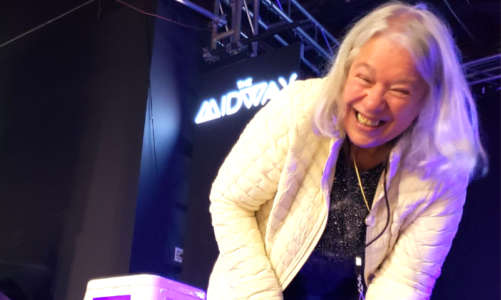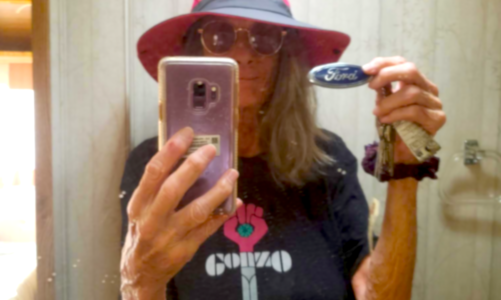[Photo by Jim Marshall]
“I think Grace and Janis gave women the balls to take a chance, to believe in themselves.”
~ Cynthia Bowman, Publicist, Jefferson Airplane, Jefferson Starship; Cynthia Bowman Public Relations
I dug seeing women dominate the 2024 Grammies; dug how they celebrated and supported each other. It took me back to SF in the ‘80s and BAWIM – Bay Area Women in Music – a networking organization for women (and men) in the music business, founded by rock journalist Sheila Rene (Sheila Rene Backstage, KSJO.)
BAWIM featured field trips to members’ workspaces, like recording studios and night clubs. For me, the highlight was a tour of the Jefferson Airplane mansion. So, I called Cynthia Bowman, who conducted the tour. We talked about the role SF played in launching so many women’s careers. “I absolutely believe that SF was ground zero for women in music – not just musicians – DJs, publicists, concert promoters,” she said.
“I remember Sheila Rene very well. She’s a good example of women who created jobs for themselves. I think we all used Sheila Rene’s Clipping Service. All the major bands did. There were women like Jan Simmons and Rita Gentry at BGP (Bill Graham Presents) … they were the ones on the phone with the Rolling Stones and the Grateful Dead, making all that stuff happen.
“Tom Donahue started KSAN in 1968 and it was the most innovative station ever in the history of radio. There was Raechel Donahue, Bonnie Simmons, Dusty Street. A good third of the DJs at KSAN were women. That was unheard of. Rolling Stone magazine, born in SF, was full-on women. The copy editor was a woman, the photo editor was a woman, the managing editor was a woman. That was really unheard of! It was a tough time for women … a time when women in publishing were typing or were receptionists. They certainly were not in powerful positions until much later.”
Then there was Janis Joplin and Grace Slick, blazing a trail for female rockers everywhere. In 1965 Grace saw Jefferson Airplane at The Matrix and in 1966 joined the band.
“She told me that that looked like a lot more fun than anything she’d done thus far. And it paid better. And you didn’t have to get dressed up. She loved that. So, she just jumped into it. None of us were really prepared for any of the stuff we did. I think women were drawn to and flourished in SF because it was a safe place to experiment with who you were and discover who you wanted to be. There were all these women who were independent creators. Fearless. It takes a lot of balls to do anything on your own. Even now, but certainly then. SF was ground zero for women on every level. It didn’t happen anywhere else. It happened here.”
###
FULL ARTICLE
I dug seeing women dominate the 2024 Grammies. Dug how they celebrated and supported each other. It took me back to San Francisco in the ‘80s and BAWIM – Bay Area Women in Music – a networking organization for women (and men) in the music business, founded by rock journalist Sheila Rene (Sheila Rene Backstage, KSJO.)
The high point of our meetings was field trips to members’ work-spaces – a recording studio managed by a woman, an all-girl band like the Contractions. But for me, the highlight was a tour of the Jefferson Airplane mansion. So, I called Cynthia Bowman, who conducted the tour. We reminisced about the role San Francisco played in launching so many careers.
“I absolutely believe that San Francisco was ground zero for women in music – not just musicians – DJs, publicists, concert promoters – BGP women,” she said. “In San Francisco, there were only a few of them in the beginning. There was Lydia Pense. Then there was Grace. And Janis. Who else was there?”
Grace was The One, as far as I was concerned. It was Grace who pulled me to San Francisco from the East Coast. “Funny you should say that,” replied CB, “because right before I ran away from New York, I was looking at the cover of some magazine, maybe LIFE, and Jefferson Airplane was on there and I thought, “Man, I wanna be like that! I was going to an Episcopalian girls’ school…it was horrible. So yeah, they brought me to San Francisco, too. It was fortuitous that I would end up working for them.
“I remember Sheila Rene very well. She’s a good example of women who created jobs for themselves. I mean that clipping service of hers. I think we all used Shelia Rene’s Clipping Service. All the major bands did.
“There were women like Jan Simmons and Rita Gentry and all of those women at BGP. The Barsotti brothers and Bill Graham got all the credit, and Jerry Pompili, but those women were actually the ones who were on the phone with the Rolling Stones and the Grateful Dead, making all that stuff happen. They really did make all that stuff happen. I know enough about this because I used to work for BGP as an independent contractor and when something needed to get done, Jan Simmons got it done, or Rita got it done…
“And the Women in Music thing, … I’m trying to remember some of the girl bands you were talking about.”
Well, there’s Kathy Peck. She was with the Contractions – an all-girl punk power trio. She also has that organization H.E.A.R. (Hearing Education and Awareness for Rockers.) Leila and the Snakes was Jane Dornacker’s group. She came up with the Bay Area Women in Music “battle cry” – BAWIMBA!
CB. “Tom Donahue started KSAN in 1968 and it was the most innovative station ever in the history of radio. There was Raechel Donahue, Bonnie Simmons, Dusty Street. That was unheard of. In 1968 there weren’t women disc jockeys at radio stations anywhere across the country. In New York City there was Cousin Brucie and I don’t remember any women at all. Period. End of story. It was unusual to have such a female-dominated radio station. But the biggest stars on that station were Raechel Donahue and Dusty Street. Well, Dusty Street was the biggest star on KSAN as far as I was concerned. She was still on the air in 2023. She died on October 21, 2023 at the age of 77. So, a good third of the DJs at KSAN were women. That was unheard of. And then there was the concert part of it, the performance part, the recording part ….
I think that in those days – I don’t think, I know, and I’m sure you do too – those were hard days for us. I mean, you were in politics, we were protesting in the streets. That was a tough time for women and any woman who was doing anything of significance, publicly or not, were the exception and not the rule. I think that’s why so many of us are the way we are. So independent and so confident, unlike the generation that preceded us. I think that San Francisco allowed us to grow in a different way and I think San Francisco was the model for the country in a lot of ways.
The music scene here inspired music scenes across the country. There were people like Bonnie Raitt. There was a whole scene going on down in Topanga Canyon, Joannie Mitchell and all those people but you certainly didn’t hear about them the way you heard about Grace and Janis in those days.
Grace was extraordinary. I mean what’s extraordinary about Grace is that she is so un-extraordinary in real life. I mean, in real life she is so un-Grace Slick. But the minute she walks on a stage, something happens that I’ve never seen happen before. I can’t explain Grace. I never could explain how she gets that way. But she was a model. When she first worked her way up here from Palo Alto, which is where she was born and raised, she was modeling at I. Magnin as a very young woman. She went to Finch College for a while and did a couple of other things but then she decided enough was enough. She was living in San Francisco and was involved with Jerry Slick, her first husband…and that first band she was in – The Great Society.
Then she saw Jefferson Airplane at the Matrix…. She told me that that looked like a lot more fun than anything she’d done thus far, and it paid better, and you didn’t have to get dressed up, and she loved that.
So, she just jumped into it.
None of us were really prepared for any of the stuff we did, I don’t think. Another good example of San Francisco being unusual, ROLLING STONE MAGAZINE was born in San Francisco. And while people like Ben (Fong Torres) and Jann (Wenner) get a lot of attention, when I was there, which was 1974 to 1976, a time when across the board women in publishing were typing or were receptionists. They certainly were not in powerful positions until much later. I guess the change started in the ‘70s but ROLLING STONE was full-on women. The copy editor was a woman, the photo editor was a woman, I can rattle off…the managing editor was a woman! That was really unheard of. She was incredible. She’d gone to Smith College. Her name was Harriet Fier. She got out of Smith, came to San Francisco, landed a job as a receptionist at ROLLING STONE and in a matter of years ended up being the managing editor.
So, there was an inordinate amount of women in charge at ROLLING STONE, at KSAN, in the performance arena and in the production arena. Women who actually made the stuff happen.
Then there were the Sheila Renes, and Marie Mandoli the Balloon Lady. She’s still around. She’s another one. She started this business and suddenly Bill Graham hired her to blow up balloons for his concerts and next thing you know, every single balloon you saw for the next thirty years…and she’s still doing it. She’s still doing it. So, there were all these women who were independent, creators and… fearless. Not afraid. It takes a lot of balls to do anything on your own. Even now, but certainly then.
I don’t know Linda Kelly but I am impressed with what she’s doing. And again, she’s representative of the kind of woman that was successful in San Francisco in the ‘60s and ‘70s. She’s made a mark for herself. Who thought in a million years that anybody would give a shit about the Haight Ashbury at this stage of the game, and yet and still, apparently they do!
San Francisco was Ground Zero for women on every level… In the 60s and 70s there were no such things as women publicists for any musician. Dennis McNally of course was with the Grateful Dead and then there was Bryn Bridenthall, who was legendary at Geffen Records. And there was me. And then suddenly women got involved on that level.
It didn’t happen anywhere else. It happened here.




